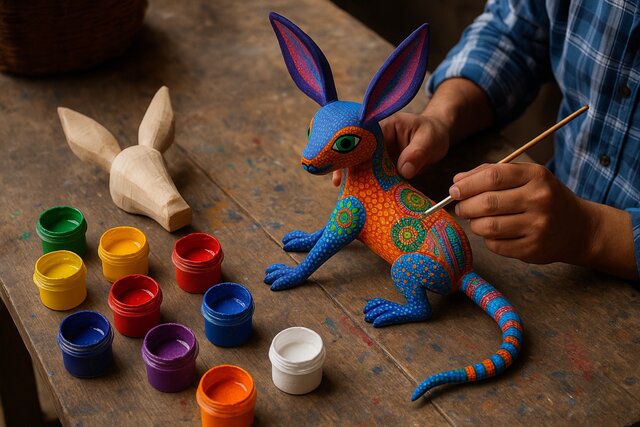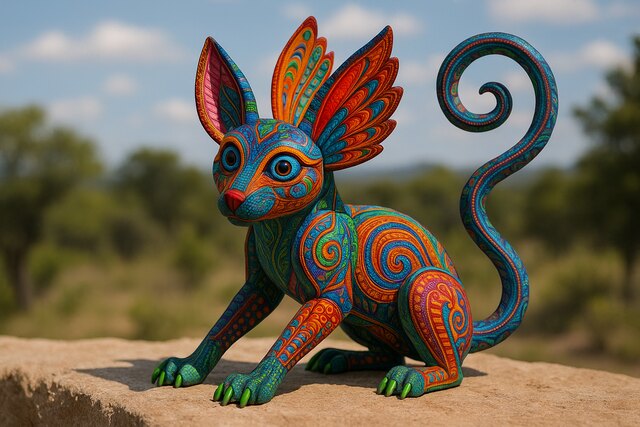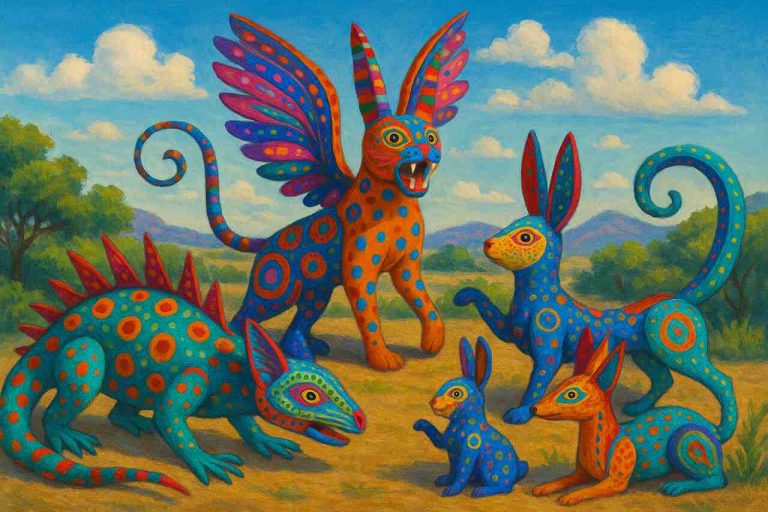Introduction
Alebrijes are among the most recognizable symbols of Mexican folk art, vivid, fantastical creatures that blend elements of animals, imagination, and cultural symbolism. Originating in the heart of Mexico, these dreamlike sculptures have evolved into an artistic tradition that bridges craft, identity, and mythology. Understanding alebrijes means exploring a world where artisans transform imagination into tangible form, blending indigenous beliefs, vibrant colors, and surreal design into one remarkable cultural artifact.
Understand the Origins and Cultural Context of Alebrijes
Alebrijes were first conceptualized by Pedro Linares López in the 1930s, a papier-mâché artisan from Mexico City who fell ill and dreamt of strange, hybrid creatures calling out “¡Alebrijes!”. Upon recovery, he recreated them through his craft, unintentionally founding one of Mexico’s most celebrated folk traditions.
These sculptures merge elements from Nahuatl mythology, Catholic symbolism, and surrealism, reflecting both indigenous and colonial layers of Mexican identity. The early alebrijes of Linares were made from cartonería, a papier-mâché technique still used today.
Beyond their whimsical look, alebrijes represent a deeper dialogue between imagination and heritage. They embody the Mexican philosophy of duality, life and death, real and mythical, human and animal, expressing a worldview where spiritual energy manifests in color and shape.
Explore the Influence of Pedro Linares López
Pedro Linares is the foundational figure behind alebrijes. His dream-inspired vision merged surrealism with Mexican craftsmanship, earning him the National Prize for Arts and Sciences in 1990. His family continues this artistic lineage in Mexico City, preserving his methods while innovating new designs that speak to modern cultural narratives.
Trace the Connection to Indigenous Mythology
Many motifs in alebrijes echo Mesoamerican mythology, such as nahuales (spirit animals) and tonas (guardian creatures). These ancient beliefs linked human destiny with animal spirits, a concept that naturally blended into the surreal creations of alebrijes. Each piece can be seen as an expression of that spiritual kinship.
Learn the Materials and Craftsmanship Behind Alebrijes

Creating alebrijes demands remarkable precision, patience, and creativity. Two main materials define the tradition: papier-mâché (cartonería) and copal wood, primarily used in Oaxaca. Each medium shapes not only the sculpture’s texture but also the cultural meaning attached to it.
In Oaxacan wood carving, artisans use copal, a soft, aromatic wood native to the region. After carving, the figures are sanded, dried, and meticulously painted with vibrant acrylics. The process can take weeks or even months depending on the complexity.
The artistry lies not just in technical skill but in storytelling. Every alebrije carries personal, familial, or local symbolism, from protective spirits to mythical beasts reflecting dreams, fears, and aspirations.
Compare Cartonería and Wood Carving Techniques
| Technique | Material | Origin | Durability | Key Regions |
| Cartonería | Papier-mâché | Mexico City | Fragile | Central Mexico |
| Wood Carving | Copal wood | Oaxaca | Long-lasting | Oaxaca, San Martín Tilcajete |
Each technique carries distinct regional signatures. Cartonería emphasizes color and surreal shape, while wood carving prioritizes texture and symbolic detail.
Examine Tools and Preparation Methods
Tools include chisels, knives, sandpaper, and paintbrushes, each used for different phases of carving. Preparation involves drying wood to prevent cracking and sketching designs inspired by nature, dreams, and mythology before painting begins. The painting phase is often collaborative, families divide work by expertise: carvers, sanders, painters, and designers.
Identify the Symbolism and Meaning Embedded in Alebrijes
Every alebrije is a symphony of color and symbolism. Bright pigments signify vitality, rebirth, and joy, while animal forms express transformation and duality. A creature combining a jaguar’s body, eagle’s wings, and serpent’s tail might symbolize power, vision, and rebirth, all integrated into one protective figure.
Colors follow symbolic logic rooted in Mexican cosmology: red represents blood and life, yellow the sun and maize, blue the divine sky, and green fertility. These symbolic elements make alebrijes more than ornaments, they are narratives rendered in pigment and form.
The symbolism also extends to personal identity. Artisans often infuse their emotional states, beliefs, or family histories into their creations, turning each alebrije into a deeply personal artifact.
Interpret Color Symbolism in Alebrijes
| Color | Symbolic Meaning | Cultural Context |
| Red | Life, energy | Blood of ancestors |
| Yellow | Sun, maize | Agricultural abundance |
| Blue | Heaven, spirituality | Connection to gods |
| Green | Fertility, nature | Earth’s renewal |
Understand Hybrid Animal Representations
Alebrijes combine animals from different ecosystems, birds, reptiles, felines, and insects, representing unity between realms. A winged lizard might connect air and earth, symbolizing balance. These combinations mirror indigenous cosmologies where multiple worlds coexist and overlap.
Explore Regional Variations Across Mexico
While alebrijes originated in Mexico City, the art form evolved distinctly in Oaxaca, where artisans like Manuel Jiménez Ramírez popularized wood-carved versions. Each region developed its own visual vocabulary, color schemes, and patterns influenced by local fauna and culture.
Oaxacan alebrijes are characterized by geometric motifs and fine brushwork, while Central Mexican versions lean toward more surreal, dreamlike structures. The Mixtec and Zapotec communities added ancestral symbolism, connecting alebrijes to traditional rituals and festivals.
The growth of alebrijes across regions demonstrates how folk art can adapt and thrive while maintaining cultural authenticity. Each variation is a dialogue between community, environment, and imagination.
Compare Mexico City and Oaxacan Alebrijes
| Region | Material | Style | Symbolism | Key Artisan Families |
| Mexico City | Papier-mâché | Surreal, lightweight | Dream imagery | Linares family |
| Oaxaca | Copal wood | Detailed, colorful | Spiritual and nature-linked | Jiménez, Morales families |
Discover the Role of Festivals and Exhibitions
Events like La Noche de los Alebrijes in Mexico City and El Taller de los Sueños in Oaxaca celebrate artisans and showcase monumental alebrijes in parades. These festivals not only preserve tradition but also engage younger generations, ensuring continuity of craftsmanship.
Apply Techniques to Create Your Own Alebrije

Crafting your own alebrije is both an artistic and spiritual exercise. The process begins with choosing your animal combination, sketching your design, and selecting materials. Whether using recycled paper or soft wood, focus on structure before color.
After assembling the base, carve or mold each part carefully, ensuring proportional balance. Then, sand or smooth the surface and prepare your palette. Acrylic paints work best for layering vibrant tones and details.
Finally, add symbolic meaning. Choose colors and patterns that represent your emotions, beliefs, or dreams. The aim is not replication but expression, an alebrije should mirror the maker’s inner world.
Gather Materials and Basic Tools
To create your own piece, you will need:
- Papier-mâché paste or copal wood blocks
- Utility knives, small chisels, sandpaper
- Acrylic paints and fine brushes
- Protective sealant
This setup provides the foundation for both beginner and advanced artisans.
Develop Design Through Symbolic Inspiration
Draw inspiration from your spirit animals or personal mythology. If you feel connected to a jaguar or hummingbird, merge those features. Add wings, scales, or horns to embody protection, transformation, or creativity. Each detail should hold symbolic intent, echoing traditional belief systems.
Support and Sustain the Alebrije Artisan Communities
Alebrije production supports hundreds of artisan families, especially in San Martín Tilcajete and Arrazola (Oaxaca). Supporting these communities ensures economic stability and cultural preservation. Many families pass techniques across generations, combining tradition with modern commerce.
Today, artisan cooperatives and fair-trade organizations play vital roles in maintaining ethical practices. Directly purchasing from recognized workshops guarantees artisans receive fair pay, while workshops offer educational programs for young artists.
Tourism, too, sustains the art, visitors often attend hands-on workshops to learn carving or painting. This exchange enriches both culture and economy, linking global admirers with local creators.
Identify Authentic Artisan Workshops
Seek certified studios such as Taller de Jacobo y María Ángeles or Taller Manos Creativas, both renowned for sustainable sourcing and training initiatives. These workshops merge ancient craft with eco-conscious practices, like replanting copal trees.
Encourage Cultural Preservation Through Education
Art programs in Oaxaca integrate alebrije-making into local curriculums. Teaching children the symbolism and technical process keeps tradition alive, while academic collaborations introduce the art to museums and global exhibitions.
Integrate Alebrijes Into Modern Art and Global Culture
In recent decades, alebrijes have transcended folk art to become global cultural icons. They appear in museums, fashion, film, and digital design, from Disney’s Coco (with the spirit guide Pepita) to contemporary art installations in Europe and the U.S.
Modern artists reinterpret alebrijes through new media, such as ceramics, metal, and digital art, expanding their meaning beyond Mexico while maintaining cultural roots. They symbolize multicultural imagination and creativity, bridging heritage and modernity.
Their global reach proves that the essence of alebrijes, transformation, imagination, and unity, resonates universally, reminding the world of Mexico’s enduring artistic soul.
Examine Alebrijes in Popular Culture
Alebrijes gained international attention through Coco, festivals, and exhibitions. This exposure increased interest in Mexican crafts and inspired hybrid forms across art disciplines. They now represent a national identity symbol as powerful as Frida Kahlo’s motifs or Day of the Dead imagery.
Explore Modern Interpretations and Innovations
Contemporary artisans use recycled materials, digital modeling, and eco-friendly paints. This evolution reflects modern sustainability concerns without losing symbolic integrity. Each reinterpretation is a continuation, not a departure, of the alebrije legacy.
Conclusion
Alebrijes embody the fusion of imagination, identity, and heritage. Born from a dream, they transformed into an enduring art form that connects generations, cultures, and philosophies. Each figure, whether papier-mâché or wood, carries a universe of meaning, uniting myth and material in dazzling color. Supporting and appreciating alebrijes means engaging with the living heartbeat of Mexican creativity, where art continues to dream.
Explore more insightful and valuable content on our blog VeoTag.com! Stay updated with helpful tips, expert advice, and in-depth articles that enhance your knowledge.
Read Also:
- Frankenstein Pumpkin: The Ultimate Guide to Creating
- Halloween Drawing Ideas for Artists of All Levels
- Chris Ayres: A Deep Dive into the Life & Legacy of the Voice-Actor Icon
- Buffstream: Free Live Sports Streaming Platform & Alternatives
- Easy Skeleton Makeup: Step-by-Step Guide for a Stunning Halloween Look
- Quikconsole Com: A Holistic Guide to Boost Your Digital Workflow
FAQ’s
Yes. While originally separate, alebrijes have been incorporated into Day of the Dead altars and parades, representing spirit guides that accompany souls on their journey.
Alebrijes are artistic interpretations of hybrid creatures, while nahuales are spiritual beings in indigenous belief systems, human-animal shapeshifters connected to destiny.
Absolutely. With basic materials and patience, anyone can learn to design and paint alebrijes. Many artisan communities offer workshops for beginners.
Color expresses energy and symbolism. Each tone carries meaning, red for life, yellow for the sun, blue for divinity, turning every alebrije into a coded narrative.
Authentic pieces are best bought directly from artisans in Oaxaca or Mexico City. Reputable workshops often certify each creation with artisan signatures.
They have inspired painters, sculptors, and filmmakers to explore surrealism and identity. Today, alebrijes represent both cultural heritage and artistic innovation.

